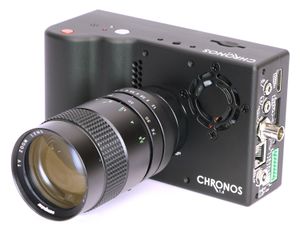High Speed Camera
Make: Chronos
Model: CH14-1.0-32C
Serial Number: 00902
Ace: Needed (Makerhub@georgefox.edu).
Location: The Vault
Description
The Cronos is a high speed camera that allows the recording of video with very high framerates, up to 1057FPS at 1280x1024, or 38,500FPS at decreased resolutions. At these high framerates, events that are too fast to be seen with the naked eye can be studied in detail. Video can be saved in RAW, CinemaDNG, or H.264 codecs.
Here is an example of this piece of equipment being used.
Insert video media here.
Documentation
Terminology
Terminology FPS - Frames per second, also known as frame rate; a measure of how quickly the camera captures images. Standard frame rates are between 24 and 60FPS. The Cronos is capable of filming at up to 38,500FPS. Exposure - How long a frame of video is actually gathering light, given in seconds. This is called Shutter Speed on most consumer cameras. Analog Gain - Called ISO in consumer cameras, digitally controls the brightness of the image. More gain means a brighter image, but also more noise (manifests as grain, especially noticeable in dark areas of the image). For the best image quality, use a low gain and compensate by increasing the amount of light where you’re filming or open the aperture if the image is too dark. Aperture - Measures the diameter of the lens's iris, given in F-stops (F1.4, F2.8, F4, etc.). The lower the number, the larger the diameter of the iris (called a wider or more open aperture) and the more light that hits the sensor. A wider aperture also decreases the depth of field (how much is in focus at a time), making the background blurry. This is bad if you are trying to film a lot of things far away from each other, but good if you need lots of light and are only filming one thing. H.264 - A common video encoding standard used commonly in online video. Generally you want to pick this one. Focus Peaking - A feature that makes it easier to see what is in focus. Highlights edges that are in focus in a color (usually red). White Balance - Controls the color temperature of light the camera is filming, measured in degrees kelvin. (Seriously, color temperature was originally defined by the color of light a bar of lead glows with at a particular temperature) Incandescent lights are around 3200K, outdoor daylight is around 5900K, LED lighting is around 5600K. Generally just adjust this by eye. If the image appears too blue, increase the color temperature. If the image appears too orange, decrease the color temperature. If adjusted correctly, white objects in the image should appear, well… white.
Trigger - Tells the camera when to stop recording. High speed cameras are always recording, and only stop and save video when stopped.
Ring buffer - The camera records frames in a “ring”, with each frame filling a new spot on the ring. When the ring is full, the next frame overwrites the first frame in the buffer. Each subsequent frame is also overwritten. This means you can start recording whenever you want, and the camera will only save the buffer when you press the trigger. By default, when you press the trigger it immediately stops recording. By going to the Trigger Delay menu, you can change it so the camera continues to record after you press the trigger (this does not work for the red record button).
User Manual
Chronos 1.4 User manual
Training
Operation
Insert Text
Demonstration
Insert text
General Procedure
Insert text
Safety
Insert text
Certification
Foxtale Quiz
Troubleshooting
Maintenance
General maintenance
Insert text
Specific Maintenance Tasks
| Maintenance Procedure | Frequency | Done By |
|---|---|---|
| Sample | Sample | Sample |
